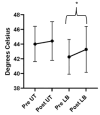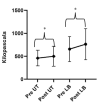Reliability of Pain Thresholds and Exercise-Induced Hypoalgesia Following 45-Degree Roman Chair Exercise
- PMID: 40182904
- PMCID: PMC11964695
- DOI: 10.26603/001c.132173
Reliability of Pain Thresholds and Exercise-Induced Hypoalgesia Following 45-Degree Roman Chair Exercise
Abstract
Background: Acute exercise may induce a reduction in pain sensitivity, termed exercise-induced hypoalgesia (EIH). The 45-degree Roman Chair (low back extension) is a dynamic resistance exercise that may be beneficial for low back pain as it allows for direct overload of the spinal flexors and extensors. However, the ability of this exercise to reliably produce EIH has not been examined.
Purpose: The purposes of this study were to determine the reliability of heat pain threshold (HPT) and pressure pain threshold (PPT) measures, examine local and systemic EIH effects after a 45-degree Roman chair exercise, and determine if EIH was produced reliably between sessions.
Study design: Observational Cohort, Crossover.
Methods: Thirty-five healthy participants (mean(SD) age: 21(1.39) years, 16 male) completed two identical sessions at least two days apart. HPT and PPT at the upper trapezius (UT) and low back (LB) were assessed pre/post quiet rest to examine reliability of these measures. HPT and PPT were repeated pre/post one set of the Roman chair exercise until failure to examine reliability of EIH. Intraclass Correlation Coefficients (ICC) examined reliability, and a three-way repeated measures ANOVA compared changes in HPT and PPT among quiet rest and exercise conditions.
Results: HPT and PPT demonstrated good (HPT: ICC3,1 >0.741) to excellent reliability (PPT: ICC3,1 >0.810). Significant EIH as assessed by PPT was demonstrated at both sites (p UT<0.025, LB<0.001) with larger effect sizes at the LB (ηp² >0.413). When assessed with HPT, significant EIH was observed over the LB (p<0.002) but not the UT (p=0.059) EIH can be reliably induced across sessions over the LB (ICC3,1 HPT=0.903, PPT=0.815)(r HPT=0.903, PPT=0.814) and UT (ICC3,1 HPT=0.867, PPT=0.729)(r HPT=0.877 and PPT=0.744).
Conclusion: The 45-degree Roman Chair may reliably induce significant hypoalgesia over the LB assessed with HPT and PPT in healthy participants.
Level of evidence: 3.
Keywords: 45-degree Roman Chair; Exercise Induced Hypoalgesia; Heat Pain Threshold; Pressure Pain Threshold; Reliability; Resistance Exercise.
© The Author(s).
Conflict of interest statement
The authors report there are no competing interests to declare.
Figures





Similar articles
-
Hypoalgesia after bicycling at lactate threshold is reliable between sessions.Eur J Appl Physiol. 2019 Jan;119(1):91-102. doi: 10.1007/s00421-018-4002-0. Epub 2018 Oct 5. Eur J Appl Physiol. 2019. PMID: 30291425
-
Exercise-Induced Hypoalgesia After Isometric Wall Squat Exercise: A Test-Retest Reliabilty Study.Pain Med. 2019 Jan 1;20(1):129-137. doi: 10.1093/pm/pny087. Pain Med. 2019. PMID: 29788440
-
Assessing Endogenous Pain Inhibition: Test-Retest Reliability of Exercise-Induced Hypoalgesia in Local and Remote Body Parts After Aerobic Cycling.Pain Med. 2019 Nov 1;20(11):2272-2282. doi: 10.1093/pm/pnz131. Pain Med. 2019. PMID: 31211385
-
Quantitative sensory testing and exercise-induced hypoalgesia protocols in low back pain: A scoping review.J Pain. 2025 Mar;28:104725. doi: 10.1016/j.jpain.2024.104725. Epub 2024 Nov 10. J Pain. 2025. PMID: 39532209
-
Does isometric exercise result in exercise induced hypoalgesia in people with local musculoskeletal pain? A systematic review.Phys Ther Sport. 2021 May;49:51-61. doi: 10.1016/j.ptsp.2020.09.008. Epub 2020 Sep 19. Phys Ther Sport. 2021. PMID: 33601254
References
-
- A meta-analytic review of the hypoalgesic effects of exercise. Naugle K. M., Fillingim R. B., Riley J. L. 2012J Pain. 13(12):1139–1150. doi: 10.1016/j.jpain.2012.09.006. https://doi.org/10.1016/j.jpain.2012.09.006 - DOI - DOI - PMC - PubMed
-
- Exercise-induced hypoalgesia after acute and regular exercise: experimental and clinical manifestations and possible mechanisms in individuals with and without pain. Vaegter H. B., Jones M. D. 2020Pain Rep. 5(5):e823. doi: 10.1097/PR9.0000000000000823. https://doi.org/10.1097/PR9.0000000000000823 - DOI - DOI - PMC - PubMed
-
- Exercise-induced hypoalgesia in healthy individuals and people with chronic musculoskeletal pain: A systematic review and meta-analysis. Wewege M. A., Jones M. D. 2021J Pain. 22(1):21–31. doi: 10.1016/j.jpain.2020.04.003. https://doi.org/10.1016/j.jpain.2020.04.003 - DOI - DOI - PubMed
-
- Exercise-Induced Hypoalgesia and Intensity of Exercise. Koltyn K. F. 2002Sports Med. 32(8):477–487. doi: 10.2165/00007256-200232080-00001. https://doi.org/10.2165/00007256-200232080-00001 - DOI - DOI - PubMed
-
- Endocannabinoid and Opioid System Interactions in Exercise-Induced Hypoalgesia. Crombie K. M., Brellenthin A. G., Hillard C. J., Koltyn K. F. 2018Pain Med. 19(1):118–123. doi: 10.1093/pm/pnx058. https://doi.org/10.1093/pm/pnx058 - DOI - DOI - PMC - PubMed
LinkOut - more resources
Full Text Sources
Research Materials
